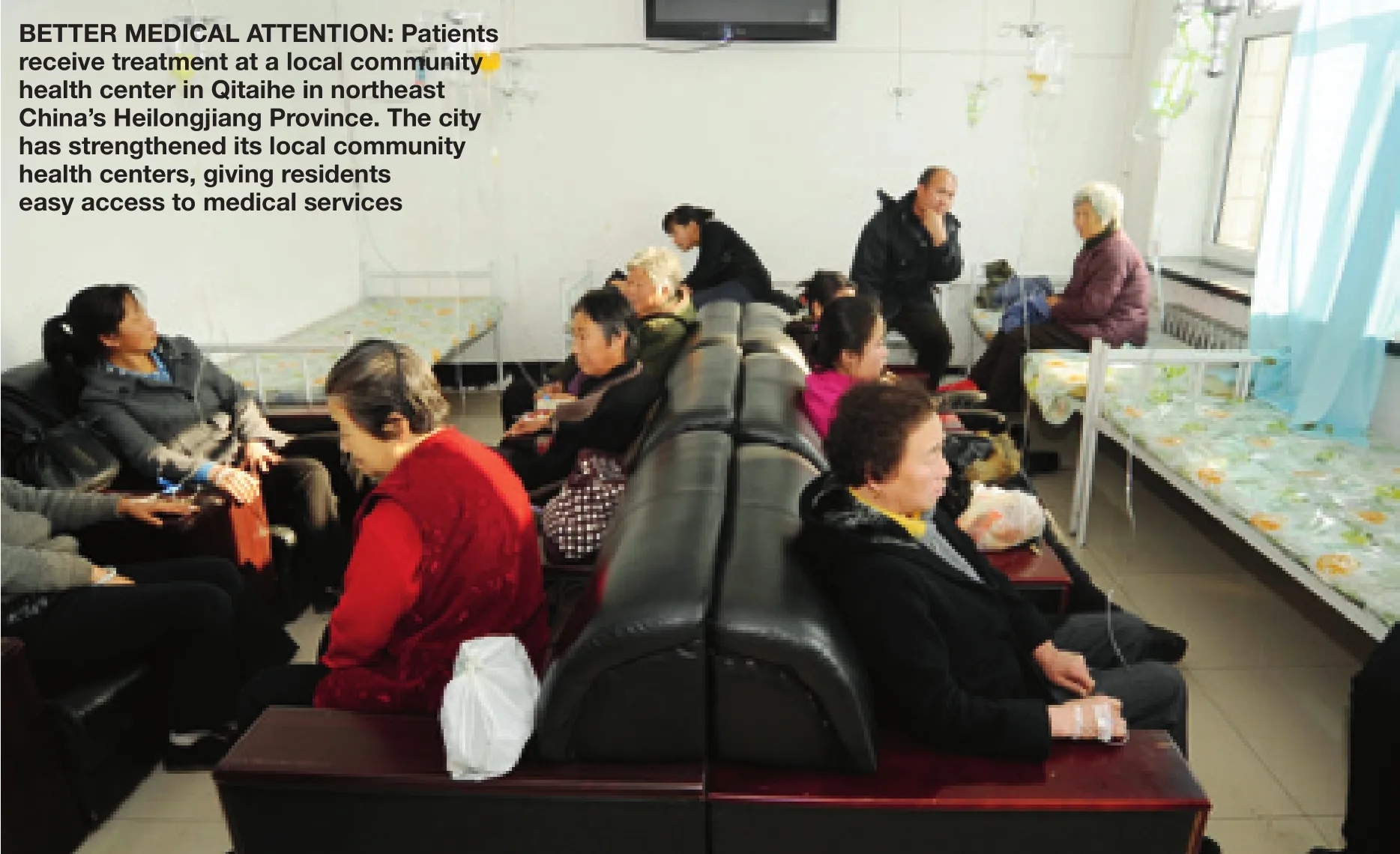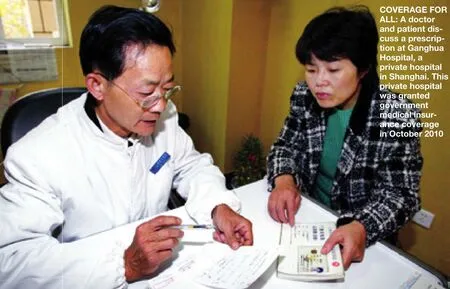A Level Field for Private and Public Hospitals
2010-10-14ByLANXINZHEN
By LAN XINZHEN
A Level Field for Private and Public Hospitals
By LAN XINZHEN
The State Council on December 3 announced new policies to encourage private and foreign capital in China’s medical sector to meet the country’s diversifying demands on health care. The new policies, dubbed the “guideline to encourage and lead social capital to sponsor health-care institutes,” stipulated that social capital should enjoy preferential treatment as China adjusts its medical resources, and social capital will be encouraged to participate in restructuring the hospital system. As an added bonus, overseas investments are being welcomed to sponsor hospitals and the process of involving more foreign investors will be further simplified in the coming years.
Non-state medical institutes vigorously developed and expanded following China’s reform and opening up in 1978. According to the Ministry of Health’sChina Health Statistical Yearbook 2010, out of 907,249 medical institutes in China in 2009 only 113,624 were backed by the government.
Although non-state hospitals far outnumbered state-run ones, their capacity to treat patients is limited. Most non-state medical institutes are small and specialize in speci fi c medical disciplines, such as ophthalmology, gynecology, andriatrics, dentistry and cosmetology, rather than comprehensive medical treatment.
The guideline also said that non-state hospitals should improve their service efficiency and quality so that state-run and nonstate medical institutions could help each other to improve.
The government will also provide more preferential policies for non-state hospitals.Social funded non-profit medical institutes will be able to enjoy the same taxation and pricing policies as government funded ones.For-profit medical facilities will pay corporate income taxes and be exempt from business taxes. As it stands, only state-run hospitals can contract medical insurance, but the guideline will change that—patients can get their expenditures reimbursed for services at non-state hospitals.
China’s medical resources accounted for only 5 percent of its GDP, much lower than the global average level of 9 percent, said Liu Guo’en, a professor with the Guanghua School of Management at Peking University.This explains why China’s medical service capacity lagged far behind people’s demand.
The policies are part of China’s new round of medical reforms launched last year and are expected to raise ef fi ciency for investors in medical institutes and facilities, said Liu.
“In fi ve to 10 years, China can settle its health care burdens and provide sufficient health care services to everyone,” Liu said.
环流形势场上,16日白天近地面华东大部为高压后部控制,高压中心位于东部海上,浅层切变位于苏皖中部。随着切变线南压,夜里12时华东东部沿海转为东南偏东风,风速3~6 m/s(图2a)。合适的风向风速条件把海上暖湿水汽向内陆输送,在遇到冷下垫面后,给华东中部沿海大范围地区带来平流大雾天气(图2b)。
Equal opportunities
According to OCN, a Shenzhen-based consulting company, the guideline will present an excellent opportunity for private capital to enter the medical sector.
Currently, sickbeds, doctors and nursing staff in private hospitals only account for 1.4 percent, 9.4 percent and 0.8 percent of China’s total, respectively. What’s more, the number of outpatients and that of patients hospitalized in private hospitals account for 7.7 percent and 2.9 percent, respectively.

QIN CUNGUANG
High taxes have been a problem impeding the development of private medical institutes. Although for-profit medical institutes are exempt from a business tax for three years after obtaining medical practice license, the fact is that it takes almost three years for hospitals to finish preparatory work including business registration, which can only be done after getting the practice licensed. In this sense, few private hospitals fully enjoy the tax exemption.
In addition, taxes levied on private hospital accounts for 11 percent of its total turnover after the three-year tax exemption period. Those taxes are value-added, sales and business income related. Business tax exemption will surely bene fi t private hospitals.
Private hospitals also do not enjoy the same market access as public ones.Hospitalized patients can’t get their expenditures reimbursed for services at private hospitals; outpatients can get their expenditures reimbursed, but the proportion is lower than from public ones. As a result, when people are deciding on which hospitals to go to, private ones are naturally their second choice.
The guideline stands to put the various medical institutes, private or public, on an even playing field. It will also further open the fi eld to foreign investments.
The Chinese Government encouraged overseas investment in the medical sector as early as the 1990s, but only joint venture hospitals were allowed, where foreign capital couldn’t exceed 70 percent of the total investment.
There are currently around 1,000 medical joint ventures in China with overseas investment mainly from the United States(30.5 percent), Hong Kong (29.3 percent),Japan, Australia, South Korea and Canada.
The guideline states that foreign investment in setting up medical institutions will be changed from the “restricted” category to the “permitted” one. Limits are relaxed on foreign share ownership in the jointly invested medical facilities. Wholly foreign-owned hospitals will go through a trial period before being gradually expanded.

WU JINGDAN
Meanwhile, application procedures and requirements for joint venture or cooperative hospitals will be streamlined. They can get approval from provincial authorities, while wholly foreign-owned hospitals must be approved by the Ministry of Health and the Ministry of Commerce.
This policy is a breakthrough, said Liu,and will bene fi t the development of foreignfunded hospitals, and bring competition to domestic hospitals, propelling domestic hospitals to improve their services.
Supervision is key
Wang Bei, 24, who rose to fame as a contestant onSuper Girl, the Chinese equivalent ofAmerican Idol, died on November 15 during facial bone-grinding surgery at Zhong’ao Cosmetic Surgery Hospital, a private hospital in Wuhan, Hubei Province.
Wang’s death stirred people’s doubts about private hospitals, which have been under public scrutiny for some time. Concerns are already rampant about whether the in fl ux in the private medical sector will trigger more medical accidents.
While private medical institutes are encouraged, supervision on them won’t be loosened, said Yin Dakui, President of the Chinese Medical Doctor Association. China issued administration regulations on medical institutions long ago, and the health executive sector is responsible for guiding private hospitals’ practice and will not loosen their supervision.
The guideline also stipulated terms on strengthening supervision on private medical institutes, requiring them to obtain licenses before practicing and prohibiting them from releasing false or misleading advertisements,said the guideline.
Private medical institutions should obey all relevant laws to achieve sustainable development, said Yin.
